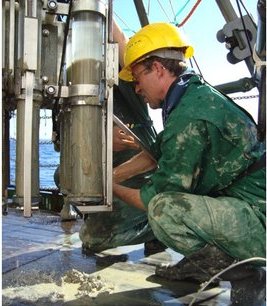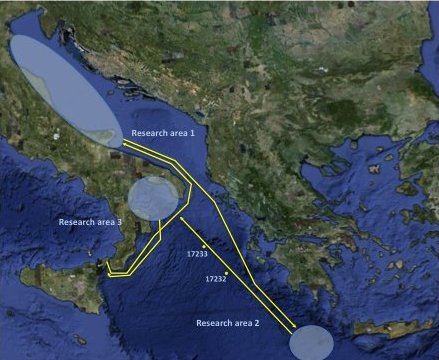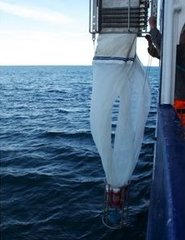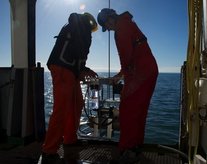Die Inhalte dieser Seite sind leider nicht auf Deutsch verfügbar.
Seitenpfad:
- AG Kucera
- Expeditionen
- CAPRICCIO
CAPRICCIO
In March 2013 the research vessel Poseidon sailed thought the Adriatic Sea, central Eastern Mediterranean Sea and Gulf of Taranto within the frame of the research program CAPRICCIO: Calabrian and Adriatic Past River Input and Carbon ConversIOn In the Eastern Mediterranean
Material has been collected for three differential national and international scientific programs that are being coordinated at the MARUM/Geoscience department of the University of Bremen:
Research consortium ANTEM (Anthropogenic and Natural forcing of the European Mediterranean climate in the last 5 Millennia) Project coordinator: PD. Dr. K. Zonneveld. Cooperation between the University Hamburg (Prof. G. Schmiedl, Prof. K. Emeis), MPI Hamburg (Dr. U. Mikolajewicz), GFZ Potsdam (Prof. A. Brauer), Univ. Leipzig (Prof. W. Ehrmann), Univ. Tübingen, PD. H. Schulz, Univ. Utercht (NL, Prof. G. de Lange), ETH Zürich, Prof. S. Bernasconi).
The DFG Funded Heisenberg Project „Biogeomolecules“ (Assessment of the formation, modification and degradation of marine kerogen at a molecular level) cooperating with the MARUM research area „Geosphere and Biosphere Interactions“. Project coordinator: Dr. G. Versteegh.
European Research Council granted project „DARCLIFE“ (Deep subsurface archaea: carbon cycle, life strategies and role in sedimentary ecosystems) cooperating with the MARUM research area „Geosphere - biosphere interactions“. Project coordinator: Prof. K-U Hinrichs.
Material has been collected for three differential national and international scientific programs that are being coordinated at the MARUM/Geoscience department of the University of Bremen:
Research consortium ANTEM (Anthropogenic and Natural forcing of the European Mediterranean climate in the last 5 Millennia) Project coordinator: PD. Dr. K. Zonneveld. Cooperation between the University Hamburg (Prof. G. Schmiedl, Prof. K. Emeis), MPI Hamburg (Dr. U. Mikolajewicz), GFZ Potsdam (Prof. A. Brauer), Univ. Leipzig (Prof. W. Ehrmann), Univ. Tübingen, PD. H. Schulz, Univ. Utercht (NL, Prof. G. de Lange), ETH Zürich, Prof. S. Bernasconi).
The DFG Funded Heisenberg Project „Biogeomolecules“ (Assessment of the formation, modification and degradation of marine kerogen at a molecular level) cooperating with the MARUM research area „Geosphere and Biosphere Interactions“. Project coordinator: Dr. G. Versteegh.
European Research Council granted project „DARCLIFE“ (Deep subsurface archaea: carbon cycle, life strategies and role in sedimentary ecosystems) cooperating with the MARUM research area „Geosphere - biosphere interactions“. Project coordinator: Prof. K-U Hinrichs.



Upper sediments, suspended matter load in the water column, water characteristics and water samples have been collected in the Adriatic Sea and Gulf of Taranto along transects located perpendicular to the coast, downstream the major eastern Italian rivers using a multicorer device, gravity corer, in-situ pumps, CTD and Rosette. This to characterise the river-specific chemical, isotopical, organic geochemical, mineral and palynological compositions of the discharge waters of the Po, Foglia, Potenza and Pescara rivers.
Oxygen concentrations of sediments have been determined with Clark-type oxygen microsensors. Information about oxygen in bottom and pore waters is required to characterise the relationship between oxygen availability and rates of selective organic matter degradation. This information is essential to estimate the potential effects of selective aerobic degradation on organic matter based proxies.
For planned incubation experiments where under controlled laboratory conditions the relationship between oxygen concentrations and aerobic degradation of organic matter will be studied, sedimentary material have been collected from he brine environments of Urania and Discovery Basin.
Additional to this, Urania Basin mud-volcanic sediments are collected with simple niskin bottles. This as the high corrosive character of the material prevents the deployment of electronic devices.
Apart from sediments and water samples, during the whole cruise the upper water column has been sampled with a multinet device to collecting living planktic foraminifera for culture experiments and their genetic characterisation.
For planned incubation experiments where under controlled laboratory conditions the relationship between oxygen concentrations and aerobic degradation of organic matter will be studied, sedimentary material have been collected from he brine environments of Urania and Discovery Basin.
Additional to this, Urania Basin mud-volcanic sediments are collected with simple niskin bottles. This as the high corrosive character of the material prevents the deployment of electronic devices.
Apart from sediments and water samples, during the whole cruise the upper water column has been sampled with a multinet device to collecting living planktic foraminifera for culture experiments and their genetic characterisation.





